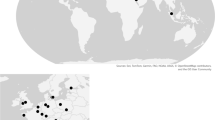Abstract
Since its introduction a century ago, isotope dilution analysis has played a central role in developments of analytical chemistry. This method has witnessed many elaborations and developments over the years. To date, we have single, double, and even triple isotope dilution methods. In this manuscript, we summarize the conceptual aspects of isotope dilution methods and introduce the quadruple dilution and the concept of exact matching triple and quadruple dilutions. The comparison of isotope dilution methods is performed by determination of bromide ions in groundwater using novel ethyl-derivatization chemistry in conjunction with GC/MS. We show that the benefits of higher-order isotope dilution methods are countered with a greater need for careful experimental design of the isotopic blends. Just as for ID2MS, ID3MS and ID4MS perform best when the isotope ratio of one sample/spike blend is matched with that of a standard/spike blend (exact matching).





Similar content being viewed by others
References
Heumann KG (1992) Mass Spectrom Rev 11:41–67
Roth E (1997) Pure Appl Chem 69:1753–1828
Meija J, Mester Z (2008) Anal Chim Acta 607:115–125
Rodriguez-Gonzalez P, Marchante-Gayon JM, Garcia Alonso JI, Sanz-Medel A (2005) Spectrochim Acta B 60:151–207
D’Ulivo A, Pagliano E, Onor M, Pitzalis E, Zamboni R (2009) Anal Chem 81:6399–6406
Pagliano E, Meija J, Sturgeon RE, Mester Z, D’Ulivo A (2012) Anal Chem 84:2592–2596
Ouerdane L, Meija J, Bakirdere S, Yang L, Mester Z (2012) Anal Chem 84:3958–3964
Henrion A (1994) Fres J Anal Chem 350:657–658
Vogl J (2012) Rapid Comm Mass Spectrom 26:275–281
Milton MJT, Wang J (2002) Intl J Mass Spectrom 218:63–73
Rienitz O, Pramann A, Schiel D (2010) Intl J Mass Spectrom 289:47–53
Pramann A, Rienitz O, Schiel D, Schlote J, Güttler B, Valkiers S (2011) Metrologia 48:20–25
Yang L, Mester Z, Sturgeon RE, Meija J (2012) Anal Chem 84:2321–2327
Patterson KY, Veillon C, O’Haver TCO (1994) Anal Chem 66:2829–2834
Milton MJT, Wielgosz RI (2000) Metrologia 37:199–206
Riepe W, Kaiser H (1966) Fres Z Anal Chem 287:121–127
Author information
Authors and Affiliations
Corresponding author
Additional information
Published in the topical collection Isotope Ratio Measurements: New Developments and Applications with guest editors Klaus G. Heumann and Torsten C. Schmidt.
Rights and permissions
About this article
Cite this article
Pagliano, E., Mester, Z. & Meija, J. Reduction of measurement uncertainty by experimental design in high-order (double, triple, and quadruple) isotope dilution mass spectrometry: application to GC-MS measurement of bromide. Anal Bioanal Chem 405, 2879–2887 (2013). https://doi.org/10.1007/s00216-013-6724-5
Received:
Revised:
Accepted:
Published:
Issue Date:
DOI: https://doi.org/10.1007/s00216-013-6724-5




